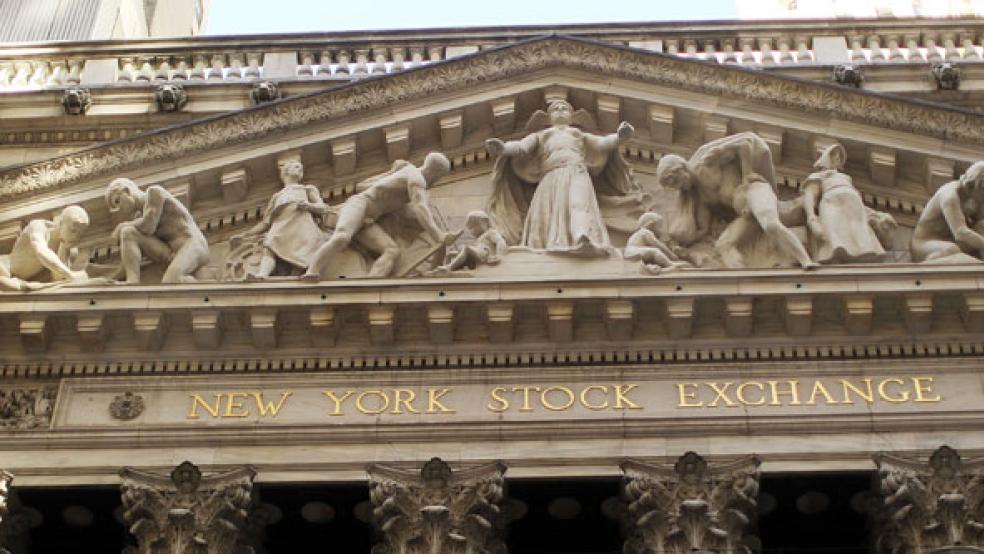Investors may think the outcome of the fierce bidding war for NYSE Euronext Inc. doesn't matter to them. They would be wrong. It has implications for trading costs, exchange practices, and regulation.
In February, the iconic New York Stock Exchange agreed to merge with German exchange giant Deutsche Börse in a $9.5 billion stock swap. The Nasdaq OMX Group and IntercontinentalExchage, or ICE, countered on April 1 with an unsolicited cash and stock offer valued at $11.3 billion. Nasdaq would take over the NYSE's stock exchange operations, including its valuable listings business—in which public companies pay fees to the exchange to list their shares so they can be traded. ICE, which operates exchanges that trade agricultural, currency and other futures, would get the derivatives-trading business, called Liffe.
Both offers face regulatory scrutiny. A merger with Deutsche Borse would create a global powerhouse, especially in derivatives trading. The combined company would handle 25 percent of global trading of futures and options, according to Macquarie Capital, well ahead of the Chicago-based CME Group. Derivatives trading is seen by many experts as a huge growth opportunity, outpacing the less lucrative stock-trading business.
One of the biggest obstacles to the Nasdaq-ICE offer, as many analysts and the NYSE itself have pointed out, is the combined listings business could face antitrust issues in the U.S. When the NYSE’s board rejected the Nasdaq-ICE’s offer Sunday, it cited concerns that the deal would face tough scrutiny, creating an “unacceptable execution risk.”
Nasdaq NYSE Euronext—the jawbreaker of a name proposed for the combined entity—would essentially dominate U.S. stock listings. Greifeld and ICE CEO Jeffrey Sprecher pointed out in a conference call announcing their bid, listings is an increasingly global business. While 2010 was a record year for initial public offerings, according to Renaissance Capital, only 16 percent of the global proceeds came from North America, the least on record. Excluding the IPO for General Motors, the U.S. portion would have been a measly 10 percent. Meanwhile, IPOs surged in the Asia-Pacific region, with 66 percent of the market.
Although there is some concern that a combined market would lead to increased trading costs, the argument that a strong global competitor to bring IPO listings to the U.S. is likely to appeal to regulators, says Rich Repetto, an analyst at Sandler O’Neill & Partners, who follows exchanges.
The NYSE is going to fight the Nasdaq offer tooth and nail. The two exchanges have been fierce competitors for years and their respective CEOs--Duncan Niederauer at the NYSE and Robert Greifeld at the Nasdaq--are not on friendly terms. Niederauer, is a veteran of exchange battles going back to the 1990s, when he worked at Goldman Sachs.
But based on current prices of the respective stocks of all companies involved , the Nasdaq-ICE bid is some 16 percent higher than the Deutsche Börse offer. While people familiar with the matter have said a Deustsche Börse has no plans to boost its offer, analysts say it likely has little choice if it wants to seal the deal.
So far, regulators haven’t commented publicly on the competing bids. For more than a decade, the Securities and Exchange Commission has pushed competition in the market in order to break the strangle-hold on trading held by dominant players such as Nasdaq and the Big Board. Today, there are roughly seventy venues where stock change hands, including about forty “dark pools” -- electronic venues that operate away from public exchanges.
The Nasdaq-ICE bid could be a step toward reducing market fragmentation, which has reduced trading costs but also contributed to trading glitches. The granddaddy of all glitches happened nearly a year ago, May 6, 2010, when the Dow Jones Industrial Average plunged nearly a thousand points in a matter of minutes before recovering, the “flash crash.”
With trading spread among so many venues, the major exchanges—Nasdaq and the NYSE—didn’t have enough buying power to counteract the broad selling and some stocks to briefly traded for as little as a penny a share. Different trading rules between the two big stock exchanges also played a role in the crash. The NYSE slowed down trading in many stocks, even as the Nasdaq and other electronic markets kept trading full blast. Nasdaq also stopped sending orders to the NYSE’s electronic arm, NYSE Arca, due to slowdowns in Arca’s data feed.
“During the last few years, we’ve witnessed a complete fracturing of the U.S. equity trading market,” ICE CEO Sprecher said during the April 1 conference call. “There’s an opportunity as part of this proposed transaction to begin to reassemble liquidity.”
Still, a combined market would account for only about half of all transactions, according to Sandler O’Neill’s Repetto. What’s more, new trading venues could spring up if the combined Nasdaq NYSE tries to push transaction costs higher. “They’d reduce choice a bit but things are so innovative and fast-moving now” that costs are likely to remain low, says Jamie Selway, managing director of Investment Technology Group, a New York brokerage that specializes in electronic trading issues.
Renewed faith in the market could go a long way. In 2010, retail investors pulled cash out of U.S. mutual funds every single month through the end of the year following the flash crash, withdrawing a total of $125.7 billion from May through December, according to fund tracker Morningstar. While flows have recovered in 2011, they remain relatively weak. The connection between investors' loss of confidence and fund flows could be a factor when review bids for the NYSE.
Related Links:
How an NYSE-Deutsche Borse Merger Would Affect Individual Investors (Forbes)
Exchanges - Here We Go Again (Investors Chronicle)
NYSE Chief Defends Merger Plan with Deutsche Borse (Financial Times)




